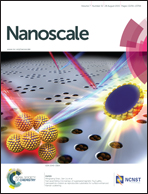A core/shell/satellite anticancer platform for 808 NIR light-driven multimodal imaging and combined chemo-/photothermal therapy†
Abstract
In this contribution, a novel multifunctional anti-cancer nanoplatform has been firstly constructed by conjugating a photothermal agent (CuS nanoparticles) and a cancer cell target agent (folic acid, FA) onto the surface of mesoporous silica coated core–shell–shell up-conversion nanoparticles (UCNPs). It was found that the doxorubicin (DOX) loaded system exhibits obvious pH and NIR-responsive release behaviour and the drug can be targetedly delivered to the cancer cells by a receptor mediated endocytosis manner. Furthermore, both photothermal therapy (PTT) and chemotherapy can be triggered simultaneously by a single 808 nm near infrared (NIR) light source, thus leading to a synergistic effect. The combined chemo- and NIR photothermal therapy can significantly improve the therapeutic efficacy compared to any single therapy, which has been evidenced by both in vitro and in vivo results. Besides, due to the doped rare earth ions, the platform also exhibits good up-conversion luminescence (UCL), computed tomography (CT) and magnetic resonance imaging (MRI) properties. Based on the excellent multimodal imaging and anti-tumor properties, the multifunctional nanoplatform should be a promising candidate for imaging-guided anti-cancer therapy.


 Please wait while we load your content...
Please wait while we load your content...